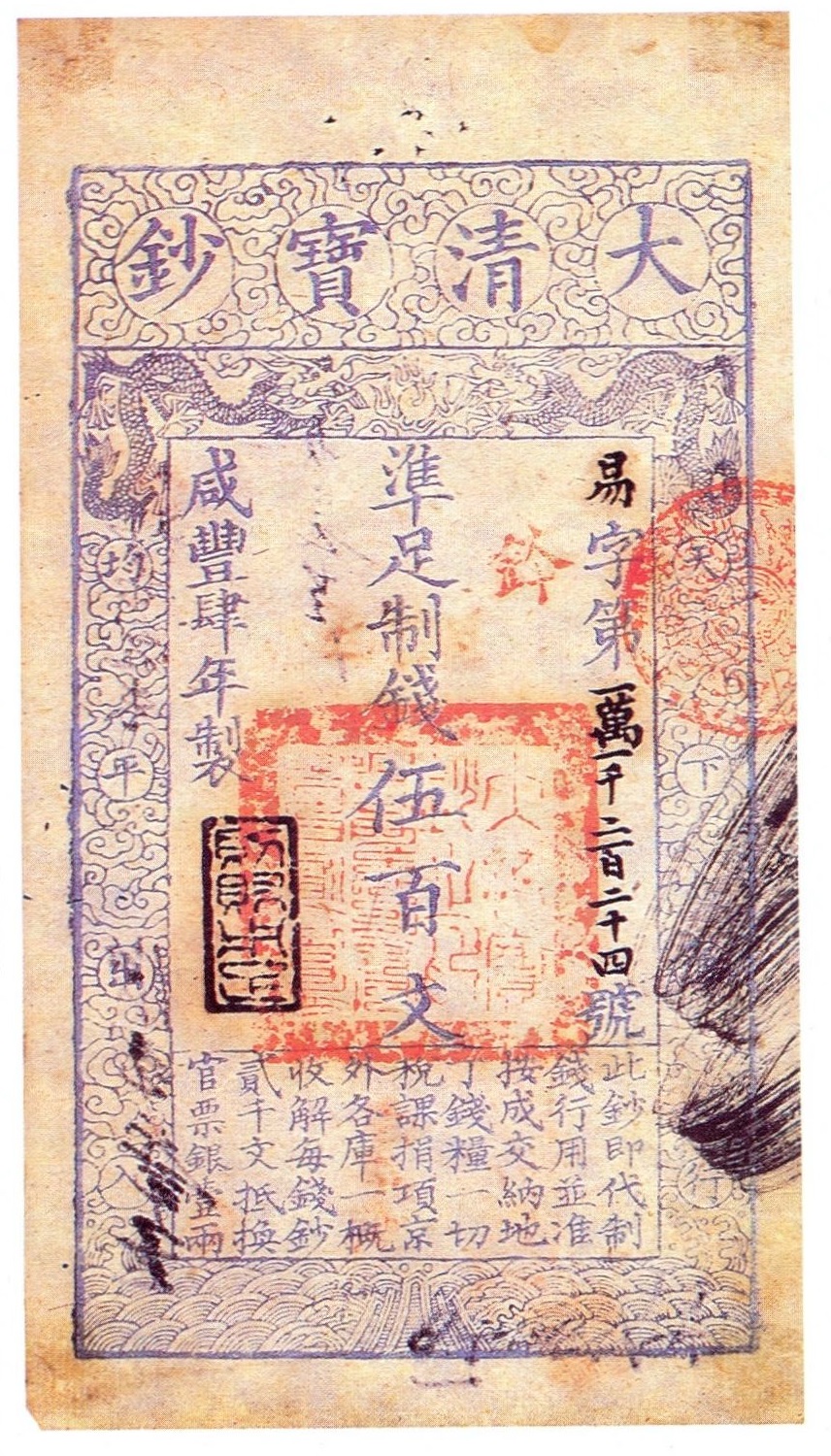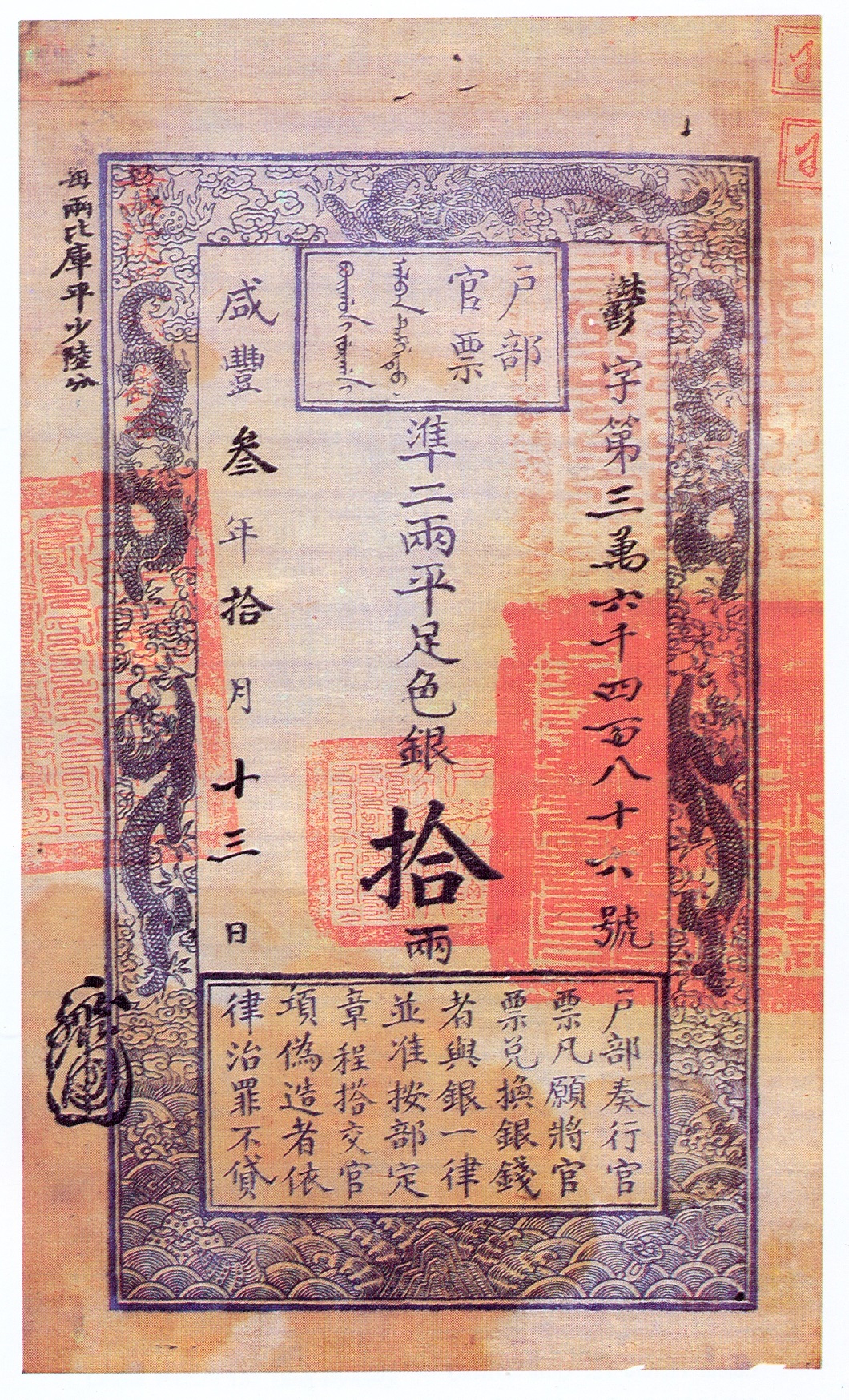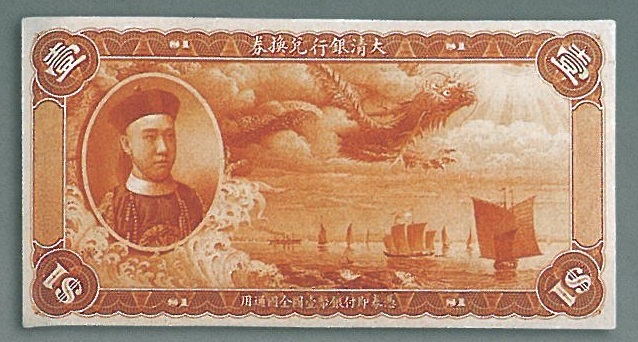Apr 13, 2016 © Ulrich Theobald
The monetary system of the Qing dynasty 清 (1644-1911) was a bimetallic one, consisting of two types of money used in two separate markets, namely silver ingots (yinliang 銀兩, yinding 銀錠) for the wholesale market and larger transactions (as well as for accounting) and copper cash (tongqian 銅錢, actually brass) for the retail market and small transactions.
The denomination of copper cash was one wen 文 (one "cash") - larger denominations being exceptions, that of the silver ingots was basically one liang 兩 (by Westerners known as one tael, from a Malay word), but there were also fractions of this value, as well as multiple ones.
The exchange rate between silver tael and copper cash was theoretically 1 : 1,000, but in daily life this rate fluctuated over time and in different places. One might say that until c. 1800 the exchange rate was in practice 1 : 7-800, but increased, for several reasons, dramatically in the early nineteenth century to about 1 : 1,200. The exchange rate was influenced by the amount of silver and copper cash on the monetary markets, but also by the quality of the copper cash. Fresh coins directly coming from the mint were appreciated higher than worn-out old coins. The normal way to bring fresh coins on the market was through the military pay (junxiang 軍餉).
Copper cash was cast by using models (fanzhu 笵鑄 - and not minted - in state-operated mints, of which there were two in Beijing, and one in almost each provincial capital. This cash was called "standard cash" (zhiqian 制錢) and was characterized by defined standards as to weight and diameter.
The primitive production process made forgery an easy business, and there were many illegal coins (siqian 私錢, sizhuqian 私鑄錢) circulating in China. They were, nevertheless, accepted by the markets because the qualitative difference between legal and illegal coins was often not that great, and because the markets demanded more money than the government was able to produce. The economy in late imperial China was a highly monetized one.
In the second half of the nineteenth century, the central government began experimenting with new types of currencies, including paper money and coins of denominations larger than one cash ("large money" daqian 大錢), and around 1880 began producing of machine-struck coins in the Western style (brass coins and silver coins). Older silver coins, particularly Spanish and Mexican foreign silver dollars, had for a centuries been used in the markets of the coastal provinces of China.
Tibet and Xinjiang, even if occupied by the Qing empire, circulated different currencies, namely Tibetan Silver Coins and Turkestan Pul Coins.
See also history of paper money in China.
 |
Da-Qing baochao 大清寶鈔 note, denomination 500 cash. Nei Menggu 1992: Pl. 16. Click to enlarge (opens in new tab). |
 |
Hubu guanpiao 戶部官票 note, denomination 10 tael. Nei Menggu 1992: Pl. 16. Click to enlarge (opens in new tab). |
During the war against the last princes of the Ming dynasty (the Southern Ming), the finances of the empire were in hard distress. Minister of Revenue, Wei Xiangshu 魏象樞, therefore suggested to introduce paper money to cover the immediate expenses. The first notes were issed in 1651 and declared invalid ten years later. An annual amount of 128,000
guan were produced, with a total sum of 1.28 million
guan. The denominations followed the pattern of the Ming period paper notes, but historiographical sources about early Qing paper money are scare, so not much can be known about them.
Only on rare occasions officials suggested to reintroduce paper money, like Cai Zhiding 蔡之定 in 1814, or Wang Yide 王懿德 in his treatise on money,
Qianbi chuyan 錢幣芻言. Yet a "private type" of paper money (
sipiao 私票) was used in the markets, namely various types of promissory notes issued by merchants of bankhouses, like
huipiao 會票,
yinpiao 銀票 "silver notes" or
qianpiao 錢票 "cash notes". Designations varied from place to place, and there were names as
pingtie 憑帖,
duitie 兌帖,
shangtie 上帖,
hupingtie 壺瓶帖 or
qitie 期帖. The denominations of such promissory notes were sometimes as high as 5
diao 吊 (i.e.
guan). The most important issuers were private banks (
qianzhuang 錢莊), but from the mid-19th century on Western credit institutes began running business in China, thus introducing modern credit instruments to the traditionial Chinese business world, like bills of exchange, promissory notes, or paper money (
fanpiao 番票).
The first kind of Qing paper money (
chaopiao 鈔票) were
Da-Qing baochao 大清寶鈔, inspired by the model of the
Da-Ming baochao 大明寶鈔 from the Ming period, but with smaller dimensions. The
baochao, denominated in copper cash (
zhiqian), were also called
qianpiao "cash notes", and issued with the denominations 250, 500, 1,000, 1,500 and 2,000
wen (or cash), later on, with the increasing inflation, also 5,000, 10,000, 50,000 and 100,000 cash. Another type of note, the
yinpiao "silver notes", was issued by the Ministry of Revenue (
hubu), and was therefore called
hubu guanpiao 戶部官票. It was denominated in silver tael, with the values 1, 3, 5, 10, and 50
liang. The notes were inscribed in Chinese characters and Manchu letters, and it was declared that they had to be discounted by two per cent when exchanged into Beijing market silver (when counted against
kuping tael, the notes were discounted at 6 per cent). The cash notes were imprinted with a note that they were convertible into copper cash, and could not be used for tax payment. The conversion rate between cash notes (
qianchao 錢鈔) and silver notes (
guanpiao) was 2 to 1. The term
chaopiao was first used only for paper notes issued by the government, but later on was also used for private paper notes issued by banks and merchant companies.
In the last few decades of the 19th century, private banks and merchant companies used two types of paper money, namely one denominated in Chinese money, and others in foreign currencies. Mackellar 麥加利, Huifeng 匯豐 (Hong Kong and Shanghai Bank of China), Dehua 德華 (Deutsch-Asiatische Bank) and Huaqi 花旗 (City Bank of New York) produced notes in tael (
yinliang 銀兩) and Chinese silver dollars (
yinyuan 銀元), the latter denominated in 1, 3, 10, 50, and 100
yuan, the former in 1, 5, 10, 50 and 100 tael/
liang. They were much used in the Yangtze River region. In Northeast China, the Russo-Chinese Bank (
Hua-E daosheng yinhang 華俄道勝銀行) issued Ruble notes (
lubu piao 盧布票), and
Japanese Banks military notes (
junyong piao 軍用票). Later on the Yokohama Specie Bank (
Yokohama shōkin ginkō 横浜正金銀行) issued gold notes (
jinpiao 金票) and Hong Kong notes (
Xiangbi 香幣) circulating in Southern China. In 1895 the first notes denominated in
yuan 圓 were issued, concurrently by the State Railway Company of Beiyang 北洋鐵軌官路局. They were printed in London and must be seen as the first modern paper bills of China, designed in a horizontal mode, in much smaller format than the traditional notes, and inscribed in Chinese and English ("Imperial Chinese Railways"). In the same year the Central Paper Money Office in Tainan 臺南官銀錢票總局 issued notes denominated in 1, 5 and 10
dayuan 大圓, and following the traditional outlook of paper notes. The monetary units
yuan 元 and 圓 were first seen during the late 18th century.
The Imperial Bank of China (
Zhonghua diguo yinhang 中華帝國銀行, in 1912 renamed Commercial Bank of China,
Zhongguo shangye yinhang 中國商業銀行) was founded in 1897, following a suggestion of Cheng Xuanhuai 盛宣懷 (1844-1916), and a year later issued the first commercial cheques (
duihuanquan 兌換券) of China, denominated in tael or in
yuan. Provincial offices also issued local notes. In Hubei, the Money Office (
guanqianju 官錢局) produced a 1,000-
wen cash note, first in the old fashion, but under the guidance of governor-general Zhang Zhidong 張之洞, a modern-style note was introduced in 1899. It was produced in Japan with high-quality methods, but had still a vertical design. In Guangdong, a modern note was introduced in 1904, denominated in 1, 5 and 10
yuan. It was also printed by the Ministry of Treasury in Japan (
Nihon ōkura shō 日本大藏省), but had a Western-style vertical design.
 |
One-Dollar note of the Ta Ching Government Bank, with the portrait of Prince Zaifeng. Dai 2008: 317. Click to enlarge (opens in new tab). |
The discussion about a national bank was ended in 1905. Peng Shu 彭述 had claimed that before introducing new paper bills, the bank would have to keep sufficient reserves in "touchable" money (
xianjin 現金). The large number of private notes was to be restricted by introducing a stamp duty (
yinhua shui 印花稅). At the end of the year the Bank of the Ministry of Revenue (
Da-Qing hubu yinhang 大清戶部銀行) was founded, and the production of the notes entrusted to the prints of the Beiyang Newspaper (
beiyang baoju 北洋報局). A year later students were sent to Japan to learn about modern printing techniques, with the aim to have the Shanghai Commercial Press 上海商務印書館 printed cheques of the Ministry's Bank. There were still two types, one set denominated in tael (
yinliang piao 1, 5, 10, 50, 100), and one in
yuan (
yinyuan piao 1, 5, 10, 50, 100). In 1907 the Ministry of Revenue was renamed XXX
duzhibu, and the bank was renamed
Da-Qing yinhang 大清銀行. Accordingly, the inscription on all notes had to be changed. Following the tradition of issuing new money in a new reign, the Xuantong administration had the design of the official paper notes somewhat changed. The new design was inspired by the US Dollar, and the bills showed the portrait of
Li Hongzhang 李鴻章, others that of Prince Zaifeng 載灃, the current Minister of Finance. At the eve of the Xinhai Revolution in 1911, there were 5.4 million tael of
yinliang notes circulating, and 12.4 million
yuan of
yinyuan notes.
Yet old notes were still in use, from the traditional private bills (printed on just one side) issued by merchants banks (
qianzhuang,
yinhao 銀號,
shangpiao 商票) and
pawn shops (
diandang 典當) and the old-style notes issued by provincial institutions, to the modern notes introduced by a dozen or so of foreign banks and modern Chinese banks which sprung up in large numbers in the very late 19th century, notes brought into the financial markets by government-owned firms like railway companies, and foreign bills coming to China through the trade ports like Shanghai. The spectrum of these types of paper bills reflected the structure of the credit market in the late Qing period.
The traditional credit institutes were local
qianzhuang,
yinhao or
piaohao 票號 banks, and pawnshops, of which a considerably number was to be found in each city. Many provincial governments founded provincial, state-owned banks (
guanqianju 官錢局 or
guanyinhao 官銀號), in some provinces even several credit institutes were to be found, like the Yuning Bank 裕寧官銀錢局 and the Yusu Bank 裕蘇官銀錢局 in Jiangsu. Quite a few of them had even branches in other provinces. Foreign banks brought a new type of financing to China and inspired Chinese entrepreneurs to found similar institutions in China, some government-owned, others run privately. Such were the
Zhongguo tongshang yinhang 中國通商銀行 (Commercial Bank of China),
Da-Qing yinhang 大清銀行,
Jiaotong yinhang 交通銀行 (Bank of Communications),
Siming yinhang 四明銀行 (Ningpo Commercial Bank),
Zhibian yinhang 殖邊銀行 (Bank of Territorial Development),
Zhejiang xingye yinhang 浙江興業銀行 (Hsing Yeh Bank or Industrian Bank of Che Kiang),
Zhejiang yinhang 浙江銀行 (Che Kiang Bank), the
Zhongguo xincheng yinhang 華商上海信成銀行 (Sin Chun Bank of China) in Shanghai, the
Xinyi gongshang chuxu yinhang 信義工商儲蓄銀行 (Hsin I Savings Bank) in Hankou, the
Chuxu yinhang 北京儲蓄 and
Baoshan yinhang 寶善銀行 in Beijing, or the
Hetai yinhang 和太銀行 and
Huashang tongye yinhang 華商通業銀行 (Chinese Mercantile Bank) in Yangzhou. Even if the number of these banks was not very high, their business had a great impact on the modernization of the financial and monetary system during the late imperial and the early Republican era. Even government-owned institutions like the railway companies can be seen as credit institutes because they issued their own paper notes.
Seen from the denominations, there was likewise a wide range of types of paper bills. The traditional copper cash was reflected in cash notes (
qianpiao), some of which used the traditional exchange rate of 1,000 cash/
wen per string (
diao), while others used differing rates, like the Eastern cash (
dongqian 東錢) of Fengtian province, with 160 cash per string, or the metropolitan cash (
jingqian 京錢) with a rate of 500 cash per string. On the markets, the exchange rates even deviated from the denominations, as had been use with cash of substandard quality since long ago. The silver currency was reflected in silver notes (
yinpiao), and also in this type of paper money, there were great differences in the conversion rate. In Beijing, the
kuping tael rate was used side by side with the metropolitan rate (
jingping liang 京平兩), while the Huifeng Bank and the
Shanghai tongshang yinhang 上海通商銀行 were both denominated in the Shanghai tael (
Shanghai wenyin 上海紋銀). The denominations on the Yuan notes (
yinyuan piao 銀元票) were most standardized, but exchange rates differed on the individual markets, depending on the value of the Silver Yuan. A last attempt at clarifying this chaotic situation were the Statutes for Paper Bills (
Tongyong yinqian piao zhangcheng 通用銀錢票章程) issued in 1909.
Sources:
Dai Zhiqiang 戴志強, ed. (2008). Zhongguo qianbi shoucang jianshang quanji 中國錢幣收藏鑒賞全集 (Changchun: Jilin chuban jituan).
Gabrisch, Karl (1990). Geld aus Tibet: Sammlung Dr. Karl Gabrisch; Ausstellung des Münzkabinetts der Stadt Winterthur (Winterthur: Departement für Kulturelles; Rikon: Tibet-Institut).
Meng Peingxing 孟彭興 (1998). "Cong feiqian dao jiaozi huizi 從“飛錢”到“交子”、“會子”, in Zhang Dainian 張岱年, ed. Zhongguo wenshi baike 中國文史百科 (Hangzhou: Zhejiang renmin chubanshe), Vol. 1, 414.
Nei Menggu qianbi yanjiu hui 內蒙古錢幣研究會, Zhongguo qianbi bianjibu 《中國錢幣》編輯部, ed. (1992); Cai Mingxin 蔡明信 (transl.). Zhongguo guchao tuji (Beijing: Zhongguo jinrong chubanshe).
Peng Xinwei 彭信威 (1954 [2007]). Zhongguo huobi shi 中國貨幣史 (Shanghai: Qunlian chubanshe), 580-581, 597-605.
Xie Tianyu 謝天宇, ed. (2005). Zhongguo qianbi shoucang yu jianshang quanshu 中國錢幣收藏與鑒賞全書 (Tianjin: Tianjin guji chubanshe), Vol. 2, 508.
Zhou Fazeng 周發增, Chen Longtao 陳隆濤, Qi Jixiang 齊吉祥, ed. (1998). Zhongguo gudai zhengzhi zhidu shi cidian 中國古代政治制度史辭典 (Beijing: Shoudu shifan daxue chubanshe), 372, 375, 380, 381, 382.
